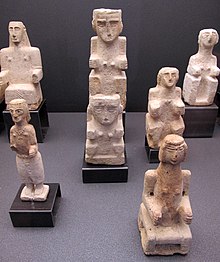

| Part of a series on |
| Ancient Near East mythology |
|---|
| Islam and other religions |
|---|
| Abrahamic religions |
| Other religions |
| Islam and... |
Religion in pre-Islamic Arabia included indigenous Arabian polytheism, Buddhism,[1] ancient Semitic religions, Christianity, Judaism, Mandaeism, and Zoroastrianism.
Arabian polytheism, the dominant form of religion in pre-Islamic Arabia, was based on veneration of deities and spirits. Worship was directed to various gods and goddesses, including Hubal and the goddesses al-Lāt, al-‘Uzzā, and Manāt, at local shrines and temples such as the Kaaba in Mecca. Deities were venerated and invoked through a variety of rituals, including pilgrimages and divination, as well as ritual sacrifice. Different theories have been proposed regarding the role of Allah in Meccan religion. Many of the physical descriptions of the pre-Islamic gods are traced to idols, especially near the Kaaba, which is said to have contained up to 360 of them, including the Buddha statue.[2]
Other religions were represented to varying, lesser degrees. The influence of the adjacent Roman and Aksumite civilizations resulted in Christian communities in the northwest, northeast, and south of Arabia. Christianity made a lesser impact in the remainder of the peninsula, but did secure some conversions. With the exception of Nestorianism in the northeast and the Persian Gulf, the dominant form of Christianity was Miaphysitism. The peninsula had been a destination for Jewish migration since Roman times, which had resulted in a diaspora community supplemented by local converts. Judaism had largely grown in South Arabia and the northwest Hijaz. Additionally, the influence of the Sasanian Empire resulted in Iranian religions being present in the peninsula. Zoroastrianism existed in the east and south, while there is evidence of either Manichaeism or Mazdakism being possibly practiced in Mecca.